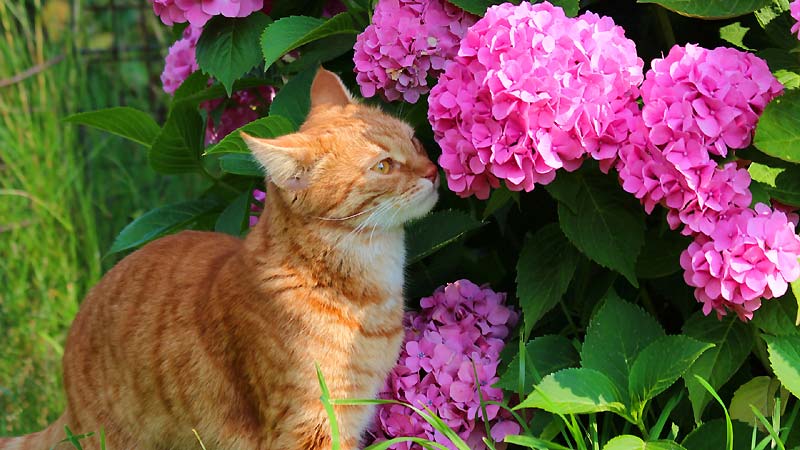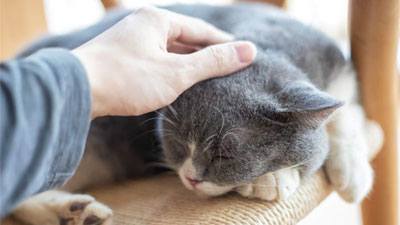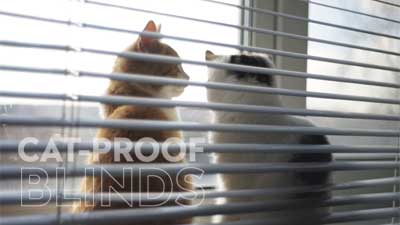The Toxic Truth: Why Are Hydrangeas Harmful to Cats?

Hydrangeas, are cherished for their vibrant blooms and ornamental appeal but harbor a perilous secret for our feline friends. Despite their enchanting aesthetics, these flowering shrubs wield a toxic potential that poses a severe threat to cats. As a pet owner, understanding the risks associated with hydrangea ingestion and implementing preventive measures is paramount to safeguarding our beloved cats.
Why Are Hydrangeas Harmful to Cats?
The hazard linked to hydrangeas stems from the presence of cyanogenic glycosides, natural chemicals found in these plants, posing a potential threat to your pet's well-being. Upon ingestion, these compounds interact with digestive enzymes, triggering the release of cyanide. This toxic cascade manifests various adverse effects in cats, such as vomiting, diarrhea, and lethargy. The severity of symptoms varies based on the hydrangea species and the quantity consumed, emphasizing the inherent danger associated with any exposure to these plants.
Among the plethora of hydrangea varieties, the Bigleaf hydrangea (Hydrangea macrophylla) stands as the most hazardous for cats. Its flowers contain a higher concentration of toxins compared to leaves or stems, amplifying the risk of severe poisoning symptoms if ingested in substantial quantities.
How to Recognizing Hydrangea Poisoning Signs in Cats
Identifying the telltale signs of hydrangea poisoning is crucial for prompt intervention.
Symptoms encompass a spectrum ranging from gastrointestinal distress, including vomiting and diarrhea, to more severe manifestations such as lethargy, difficulty breathing, seizures, and rapid heart rate. Cats exhibiting any of these symptoms after potential exposure to hydrangeas necessitate immediate veterinary attention.
How to Responding to a Hydrangea Ingestion Incident
Swift action in response to a suspected hydrangea ingestion is pivotal.
If observed consuming hydrangea foliage, removing the cat from the plant vicinity is paramount to prevent further ingestion. Contacting a veterinarian immediately to apprise them of the incident is essential. Depending on the severity and symptoms displayed, the veterinarian might recommend an examination or provide guidance for at-home monitoring.
Vigilance in monitoring the cat for abnormal behaviors or symptoms post-ingestion is imperative. Any indication of distress, including vomiting, diarrhea, or lethargy, warrants immediate veterinary care. Carrying a sample of the plant for identification purposes can aid in determining the appropriate treatment protocol.
Preventive Strategies: Mitigating Hydrangea Exposure
Creating a safe environment for feline companions involves strategic placement of potentially harmful plants. Hydrangeas, given their toxic nature, should be situated in areas inaccessible to cats. This involves elevating the plants on high shelves or securing them behind closed doors. Exploring alternative cat-safe flora for indoor or outdoor spaces becomes an imperative consideration for responsible pet ownership.
Hydrangeas are not solitary in their toxic implications for pets. Researching and identifying other hazardous plants commonly found indoors or outdoors is crucial. Restricting access to these plants, coupled with close supervision, is fundamental for outdoor cat safety. Transitioning cats to an indoor environment, complemented by secure outdoor enclosures or leash training, provides safer avenues for outdoor exploration while mitigating plant exposure risks.
Besides that, you can consult the ASPCA Plant Database offers comprehensive insights into both toxic and non-toxic plants, aiding in informed decisions regarding plant selections within pet-inhabited spaces.
In Case of Emergencies: Equipping for Prompt Response
Preparedness is key during pet emergencies. Maintaining contact information for the primary veterinarian and an emergency animal hospital ensures rapid access to professional assistance. In the event of plant ingestion or suspected poisoning, immediate action supported by expert guidance enhances the prospects of a positive outcome for the cat's health.
You May Also Like
 Tips and TricksCaring for Your Whiskered Companion: Essential Tips for Cat Health
Tips and TricksCaring for Your Whiskered Companion: Essential Tips for Cat Health Cat Nutrition & Food10 Kinds of Human Food That Are Good for Cats
Cat Nutrition & Food10 Kinds of Human Food That Are Good for Cats Cat-Proof Blinds8 Best Cat-Proof Blinds: Durable, Easy to Install, and Long-Lasting
Cat-Proof Blinds8 Best Cat-Proof Blinds: Durable, Easy to Install, and Long-Lasting Cat HealthCan Cats Eat Chocolate? The Answer Is an Emphatic "No!"
Cat HealthCan Cats Eat Chocolate? The Answer Is an Emphatic "No!" Cat BehaviorIf The Cat Is Well Raised, There Will Be These 6 Behaviors!
Cat BehaviorIf The Cat Is Well Raised, There Will Be These 6 Behaviors! Cat HealthHow Are Indoor Cats Get Infected?
Cat HealthHow Are Indoor Cats Get Infected?